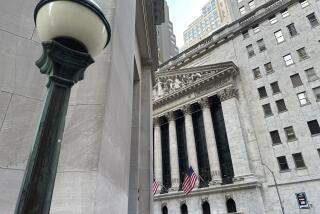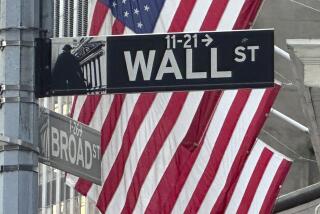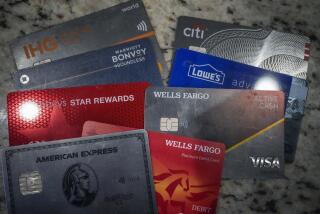Bond Market Facing Some Important Tests
If the bond marketâs wild 1995 rally is finally going to run out of gas, the next few weeks would seem to be a logical time.
Since July 6--the day the Federal Reserve Board cut short-term interest rates for the first time in three years--longer-term bond yields have been creeping higher, defying Wall Streetâs script.
The Fedâs move was supposed to lead to lower bond yields, not higher ones. Instead, while investors initially considered the Fed cut to be an indication that the economy was risking recession, that view has faded.
Now, the bellwether 30-year Treasury bond yield is threatening to cross 7% for the first time since mid-May. A slew of economic reports due over the next three weeks could spur a bond selloff that would send all yields higher as investors weigh the impact of the economyâs revival against hopes for more Fed rate cuts.
Adding to worries, on Wednesday the Treasury will announce plans for its quarterly auction of 3-, 10- and 30-year securities, to take place Aug. 8 through 10. An estimated $41 billion in notes and bonds are expected to be sold, a heavy supply at a time when investorsâ appetite for fixed-income securities may be waning.
Of course, Wall Street bears have been sounding the death knell for bondsâ rally all year, and theyâve been wrong. Tracking the slowing economy, the 30-year T-bond yield fell from 7.88% on Jan. 1 to a low of 6.47% on June 22, and held just slightly above that level until two weeks ago.
But then a series of government reports suggested that the decline in business activity and consumer spending was bottoming. While the governmentâs report last Friday on second-quarter gross domestic product growth estimated the economy advanced at an annualized rate of just 0.5%--the slowest in nearly four years--that is now ancient history as far as the bond market is concerned.
In their usual warped fashion, many bond investors had been hoping for outright recession this summer to justify even lower interest rates.
Instead, economist Stephen S. Roach at Morgan Stanley & Co. in New York argues that âthe U.S. economy now appears to be in the early stages of a rebound. . . . The consumer is on the mend, capital spending continues to boom, home building is poised for an imminent rise and the [business] inventory correction is running its course.â
*
Spooked by recent data that seems to support Roachâs thesis, bond traders have pushed the yield on the 30-year T-bond to 6.90% as of Friday, up from 6.50% on July 6.
Likewise, the two-year T-note yield has risen from 5.52% to 5.94% in that period.
âPeople who were committed to the bond market feel much less certain about those commitments now,â says Anthony Karydakis, senior financial economist at First Chicago Capital Markets. âI think the market is demoralized.â
To be sure, there are plenty of bond pros who believe the market is just psyching itself out temporarily, for no good reason.
John R. Williams, economist at Bankers Trust Co. in New York, agrees that the economyâs pace will pick up in the current quarter. But he predicts modest growth at best, and therefore still expects the Fed to lower short-term interest rates further by yearâs end.
The Fedâs benchmark short-term rate--the federal funds rate--should fall to around 5% by 1996 from 5.75% currently, Williams says. If heâs right, long-term bond yields should have plenty of room to fall further this year.
Optimists such as Williams base their forecasts in part on the Fedâs history: Once the central bank begins cutting short-term rates, as it did on July 6, it almost always engineers a series of cuts. Rarely does the Fed ease once, then raise rates soon afterward.
But some economists are worried that the Fed miscalculated and cut rates too soon. âThe Fed could well be among the most surprised by the economyâs potential vigor,â Roach says. The July 6 rate cut, he says, âmay well have to be reversed by year-end if the economy accelerates as we believe.â
If government data over the next few weeks shows the economy recovering more quickly than expected, concern that the Fed may have erred in easing credit could easily push the 30-year T-bond yield over 7% and the two-year T-note yield over 6%.
Both are psychologically important barriers for the bond market, and crossing them could trigger a rash of selling by speculators who bought bonds at lower yields and thus are already under water.
Sellers nearly succeeded in breaching the 6% and 7% walls on July 21, as the two-year T-note hit 5.99% and the 30-year T-bond reached 6.96%. But buyers quickly returned to the market early last week. By Friday, however, yields were rising again.
*
Investorsâ appetite for bonds will be sorely tested this week. Economic reports on the calendar include the National Assn. of Purchasing Managementâs July manufacturing index on Tuesday; June new home sales on Thursday, and July employment on Friday.
Next week, as the Treasury launches its quarterly auction of 3-, 10- and 30-year bonds, the market will have to contend with July inflation reports and the Fedâs âbeige bookâ report on regional economic activity.
Karydakis worries most about the potential for a spike in shorter-term bond yields--such as on the two-year T-note.
Itâs in that shorter-term end of the âyield curveâ that many speculators have made bets on lower interest rates. In addition, if the Fed were to reverse itself and begin boosting very short-term interest rates, like the federal funds rate, the greatest impact would be on securities in the three-month to five-year range.
âItâs the front end of the curve that will be in trouble,â Karydakis contends.
Pessimists like Roach believe the two-year T-note yield will climb to 6.5% by yearâs end.
And longer-term bond yields, which in theory should respond more to inflation trends than to the Fedâs short-term rates, also could rise quickly, if for no other reason than that trading is thin with many market players on vacation.
âI think weâre bound to see 7% againâ on the 30-year T-bond, says Robert DiClemente, economist at Salomon Bros. in New York. Summer markets, he notes, are âcapable of moving on thin air.â
*
Yet the higher yields go, the more attractive they should become to long-term investors, if not to speculators, DiClemente and other pros argue.
The cyclical trend in bond yields may be up, but the secular trend still is down, many Wall Streeters insist. Look ahead a few years, they say, and imagine a world where inflation still is extremely low, the U.S. budget deficit has shrunk and the aging U.S. populationâs savings rate is higher.
âI think the fundamentals for the bond market are as favorable as theyâve been in a long time,â says Joan Payden, principal at Payden & Rygel in Los Angeles, which manages about $18 billion in bonds.
What investors tend to forget, Payden and other pros say, is that historically interest rates--both nominal and inflation-adjusted--have been lower than todayâs rates. Despite blips along the way, the optimists still see bonds working their way down to more normal levels.
So if yields back up in the near-term, Payden says, âIâd be a buyer.â
(BEGIN TEXT OF INFOBOX / INFOGRAPHIC)
Backup in Yields
How yields on certain Treasury securities have risen since the Federal Reserve Board cut short-term interest rates July 6.
6-month July 6: 5.48% Friday (July 28): 5.62%
2-year July 6: 5.52% Friday (July 28): 5.94%
30-year July 6: 6.50% Friday (July 28): 6.90% Source: Los Angeles Times
More to Read
Inside the business of entertainment
The Wide Shot brings you news, analysis and insights on everything from streaming wars to production â and what it all means for the future.
You may occasionally receive promotional content from the Los Angeles Times.










